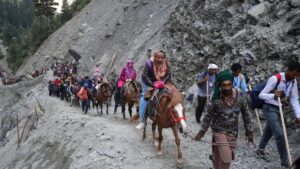Table of Contents
Humboldt’s Enigma and What does it mean for India?
Context: Alexander von Humboldt (1769-1859), observed a link between mountain climates and biodiversity. Modern biogeographers – scientists named this link “Humboldt’s enigma” and seek to understand it further.
What Is Humboldt’s Enigma?
- Tropical Diversity: Tropical areas receive more solar energy due to Earth’s tilt, leading to higher primary productivity.
- This creates more ecological niches and greater biodiversity in the tropics.
- Humboldt’s enigma: postulates that the earth’s tropical areas by themselves don’t contain all the biodiverse regions; mountains,despite lying outside the tropics, are highly biodiverse. This is contrary to expectations of declining diversity away from the tropics.
- Mountains offer diverse habitats due to varied elevations and climates, defying the simple latitude-diversity relationship.
- India’s Case Study: Tropical regions like the Western Ghats are expected to be highly diverse in India.
- However, the eastern Himalayas surprisingly exhibit even greater biodiversity, especially for birds.
- Significance of Humboldt’s Enigma: Understanding this phenomenon is crucial for conserving and managing biodiversity in mountains, which are vital ecological hotspots.
Mountain Biodiversity Drivers
- Cradles: Geological processes like uplifts create new habitats, fostering evolution of new species.
- Museums: Climatically stable mountains allow species to persist and accumulate over time.
- Geology: Diverse rock types lead to increased habitat heterogeneity and thus more biodiversity (especially in the tropics).
Example of Chimborazo
- The northern Andes range – including Chimborazo – is considered the most biodiverse place in the world.
- A large variation over short distances ( from tropical evergreen biomes in the lower elevation to the alpine and tundra biomes near the top) supports the immense biodiversity.
Example of Shola Sky Islands in Western Ghats (tropical coastal sky islands)
- Old lineages survived climate fluctuations on mountain tops while lowland habitats changed.
- Sholicola and Montecincla birds are relics of this ancient diversity.
Challenges in Understanding Biodiversity Patterns:
- Data limitations: Lack of fine-scale data on species occurrence.
- Understudied areas, especially in India.
- Inadequate research: Need for more dedicated research efforts.
- Genetic information gap: Importance of utilising modern genetic tools for accurate understanding.
We’re now on WhatsApp. Click to Join
Digi Yatra
Context: A recent survey has pointed out that most air travellers used Digi Yatra unknowingly or were compelled to, with few aware of its benefits.
About Digi Yatra
What is it?
- Contactless, seamless passenger processing at airports using Facial Recognition Technology (FRT).
- Requires one-time registration with Aadhaar and self-image capture on the Digi Yatra app.
Benefits:
- Improved passenger convenience and ease of travel.
- Places India among world-class airports like Heathrow and Atlanta.
Privacy Features:
- No central storage of personal data.
- Data stored securely in a passenger’s smartphone wallet.
- Blockchain technology and 24-hour data purging ensure privacy.
Efficiency:
- Saves passenger time: Dubai Airport saw 40% reduction, Atlanta Airport 9 minutes per aircraft.
Current Status:
- Launched for domestic flights only.
- Voluntary participation.
Concerns regarding Digi Yatra
- Lack of Awareness and Consent: Signed up unknowingly, mistaking the queue for the regular one.
- Coercion and Lack of Choice: 15% signed up because the “regular queue” was unavailable.
- Privacy Concerns: Lack of clarity on who has access to the data and how it is stored.
- Concerns with Implementation:
- Heavy traffic and chaos at airports, especially Delhi.
- This raises questions about system readiness for wider rollout.
ICJ – Interim Judgement on Gaza
Context: The interim decision from the International Court of Justice regarding Israeli actions in Gaza underscores the moral obligation for global adherence to humanitarian standards and accountability.
About International Court of Justice (ICJ)
- Established: June 1945, Charter of the United Nations
- Headquarters: Peace Palace, The Hague (Netherlands) {Only UN organ not in New York}
- Public hearings, official languages: English and French.
- Powers and Functions:
- Handles contentious cases between states and advisory proceedings.
- Only UN member states or those recognizing the court’s jurisdiction can engage in contentious cases.
- Offers opinions to UN organs and specialised agencies.
- Judgments are final and binding in contentious cases; advisory opinions are not binding.
- Decision-making: Based on international law: treaties, custom, general principles, legal decisions, expert writings.
- Composition:
- 15 judges from different countries.
- 9-year terms, elected by UNGA and UNSC.
- One-third renewed every 3 years, re-election possible.
- Independent judges, impartial and conscientious.
Beating Retreat
Context: Recently the Beating Retreat ceremony was held at Vijay Chowk in New Delhi.
About Beating Retreat Ceremony
- Marks: The end of Republic Day festivities.
- Origin in India: In 1950s, when Major Roberts of the Indian Army indigenously developed the unique ceremony of display by the massed bands.
- Held on: The evening of January 29th.
- Organised by: The Ministry of Defence (Section D).
- Performed by:
- Army, the Navy, the Air Force and the State Police and the Central Armed Police Force (CAPF)
- Since 2016: Bands of Central Armed Police Forces & Delhi Police were included.
- Venue: Raisina Hills & Vijay Chowk.
- Chief guest: President of India.
| Beating Retreat Ceremony 2024
● For the first time, the CRPF had a women-led band. |
Indian Navy ship INS Sumitra foils hijack attempt on fishing vessel
Context: The Indian Navy ship INS Sumitra deployed in the Gulf of Aden successfully released 17 crew members and the Fishing Vessel (FV) Iman from pirates without harm.
More In News
- Indian Navy MARCOS commandos thwarted a hijack attempt on the merchant vessel Lila Norfolk in the North Arabian Sea, rescuing 21 crew members, including 15 Indians.
- Destroyers and frigates are actively deployed for maritime security operations, ready to assist merchant vessels in distress.
- There is increased use of long-range maritime patrol aircraft and Unmanned Aerial Vehicles for comprehensive maritime domain awareness.
United Nations Relief and Works Agency for Palestine Refugees in the Near East (UNRWA)
Context: UN officials urged countries to reconsider their decision to suspend the funding for the United Nations agency for Palestinian refugees (UNRWA).
About UNRWA
- Mission: Support and improve the lives of Palestinian refugees and their descendants.
- Origin: Established in 1949 after the 1948 Arab-Israeli war.
- Mandate: Originally temporary, but renewed every 3 years by the UN General Assembly.
- Services: Education, healthcare, relief, infrastructure, microfinance, emergency assistance.
- Areas of operation: Jordan, Lebanon, Syria, Gaza Strip, West Bank (including East Jerusalem).
- Uniqueness: Delivers services directly to beneficiaries.
- Funding: Voluntary contributions from UN members and some regular UN budget funds.
- Reporting: Only to the UN General Assembly.
- Headquarters: Currently in Gaza Strip (previously Beirut and Vienna).
- Leadership: Commissioner-General appointed by UN Secretary-General with Assembly approval.
Lab-Grown Seafood
Context: ICAR-Central Marine Fisheries Research Institute (CMFRI) collaborated with a private-sector start-up (Neat Meat Biotech) to grow fish meat in the laboratory.
About Lab-Grown Seafood
- Type: Cultivated/ cultured lab grown meat.
- Production: Specific fish cells are cultured in a lab setting.
- Produced by: Isolating specific cells from fish and growing them in a laboratory setting using media that is free of animal components.
- End Product: Mimics the taste, texture, and nutrition of conventional fish meat.
What Is the Need?
- Addresses increasing seafood demand without overfishing.
- Reduces pressure on wild fish populations and ecosystems.
- Offers potential solutions for future food supply stability.
- Provides an alternative to traditional fishing, potentially reducing ocean exploitation.
- Eliminates the risk of antibiotics, microplastics, and heavy metal contamination.


 Operation Shiva 2025: Indian Army’s Ma...
Operation Shiva 2025: Indian Army’s Ma...
 World Youth Skills Day 2025, Theme, Hist...
World Youth Skills Day 2025, Theme, Hist...
 President Murmu Nominates Four Members t...
President Murmu Nominates Four Members t...





















